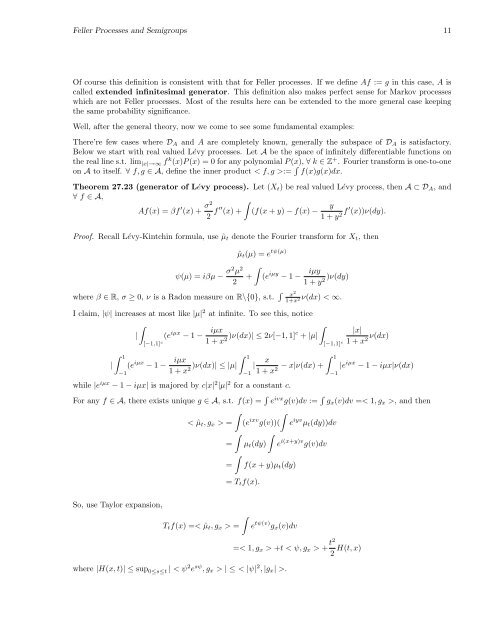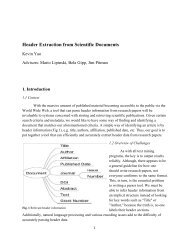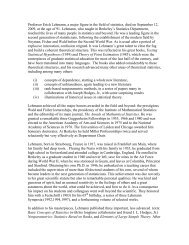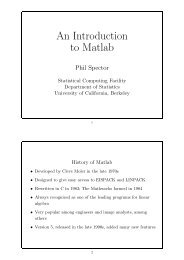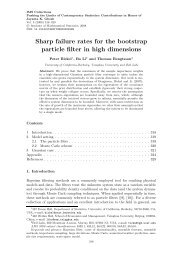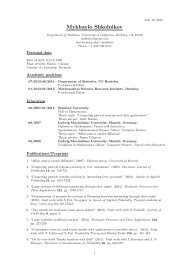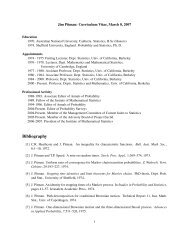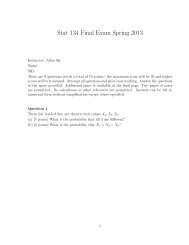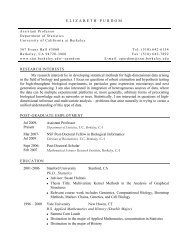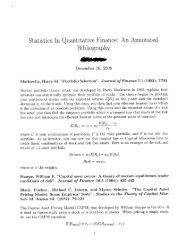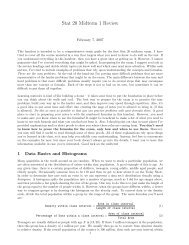Feller Processes and Semigroups
Feller Processes and Semigroups
Feller Processes and Semigroups
Create successful ePaper yourself
Turn your PDF publications into a flip-book with our unique Google optimized e-Paper software.
<strong>Feller</strong> <strong>Processes</strong> <strong>and</strong> <strong>Semigroups</strong> 11<br />
Of course this definition is consistent with that for <strong>Feller</strong> processes. If we define Af := g in this case, A is<br />
called extended infinitesimal generator. This definition also makes perfect sense for Markov processes<br />
which are not <strong>Feller</strong> processes. Most of the results here can be extended to the more general case keeping<br />
the same probability significance.<br />
Well, after the general theory, now we come to see some fundamental examples:<br />
There’re few cases where D A <strong>and</strong> A are completely known, generally the subspace of D A is satisfactory.<br />
Below we start with real valued Lévy processes. Let A be the space of infinitely differentiable functions on<br />
the real line s.t. lim |x|→∞ f k (x)P (x) = 0 for any polynomial P (x), ∀ k ∈ Z + . Fourier transform is one-to-one<br />
on A to itself. ∀ f, g ∈ A, define the inner product < f, g >:= ∫ f(x)g(x)dx.<br />
Theorem 27.23 (generator of Lévy process). Let (X t ) be real valued Lévy process, then A ⊂ D A , <strong>and</strong><br />
∀ f ∈ A,<br />
∫<br />
Af(x) = βf ′ (x) + σ2<br />
2 f ′′ (x) + (f(x + y) − f(x) −<br />
y<br />
1 + y 2 f ′ (x))ν(dy).<br />
Proof. Recall Lévy-Kintchin formula, use ˆµ t denote the Fourier transform for X t , then<br />
ψ(µ) = iβµ − σ2 µ 2<br />
2<br />
ˆµ t (µ) = e tψ(µ)<br />
∫<br />
+ (e iµy − 1 − iµy<br />
1 + y 2 )ν(dy)<br />
where β ∈ R, σ ≥ 0, ν is a Radon measure on R\{0}, s.t. ∫ x 2<br />
1+x 2 ν(dx) < ∞.<br />
I claim, |ψ| increases at most like |µ| 2 at infinite. To see this, notice<br />
∫<br />
| (e iµx − 1 −<br />
iµx<br />
∫<br />
[−1,1] 1 + x 2 )ν(dx)| ≤ 2ν[−1, 1]c + |µ|<br />
c<br />
|<br />
∫ 1<br />
−1<br />
(e iµx − 1 − iµx<br />
1 + x 2 )ν(dx)| ≤ |µ| ∫ 1<br />
while |e iµx − 1 − iµx| is majored by c|x| 2 |µ| 2 for a constant c.<br />
−1<br />
[−1,1] c<br />
|x|<br />
1 + x 2 ν(dx)<br />
∫<br />
x<br />
1<br />
|<br />
1 + x 2 − x|ν(dx) + |e iµx − 1 − iµx|ν(dx)<br />
For any f ∈ A, there exists unique g ∈ A, s.t. f(x) = ∫ e ivx g(v)dv := ∫ g x (v)dv =< 1, g x >, <strong>and</strong> then<br />
∫<br />
∫<br />
< ˆµ t , g x > = (e ixv g(v))( e iyv µ t (dy))dv<br />
∫ ∫<br />
= µ t (dy) e i(x+y)v g(v)dv<br />
∫<br />
= f(x + y)µ t (dy)<br />
= T t f(x).<br />
−1<br />
So, use Taylor expansion,<br />
∫<br />
T t f(x) =< ˆµ t , g x > =<br />
e tψ(v) g x (v)dv<br />
where |H(x, t)| ≤ sup 0≤s≤t | < ψ 2 e sψ , g x > | ≤ < |ψ| 2 , |g x | >.<br />
=< 1, g x > +t < ψ, g x > + t2 H(t, x)<br />
2


